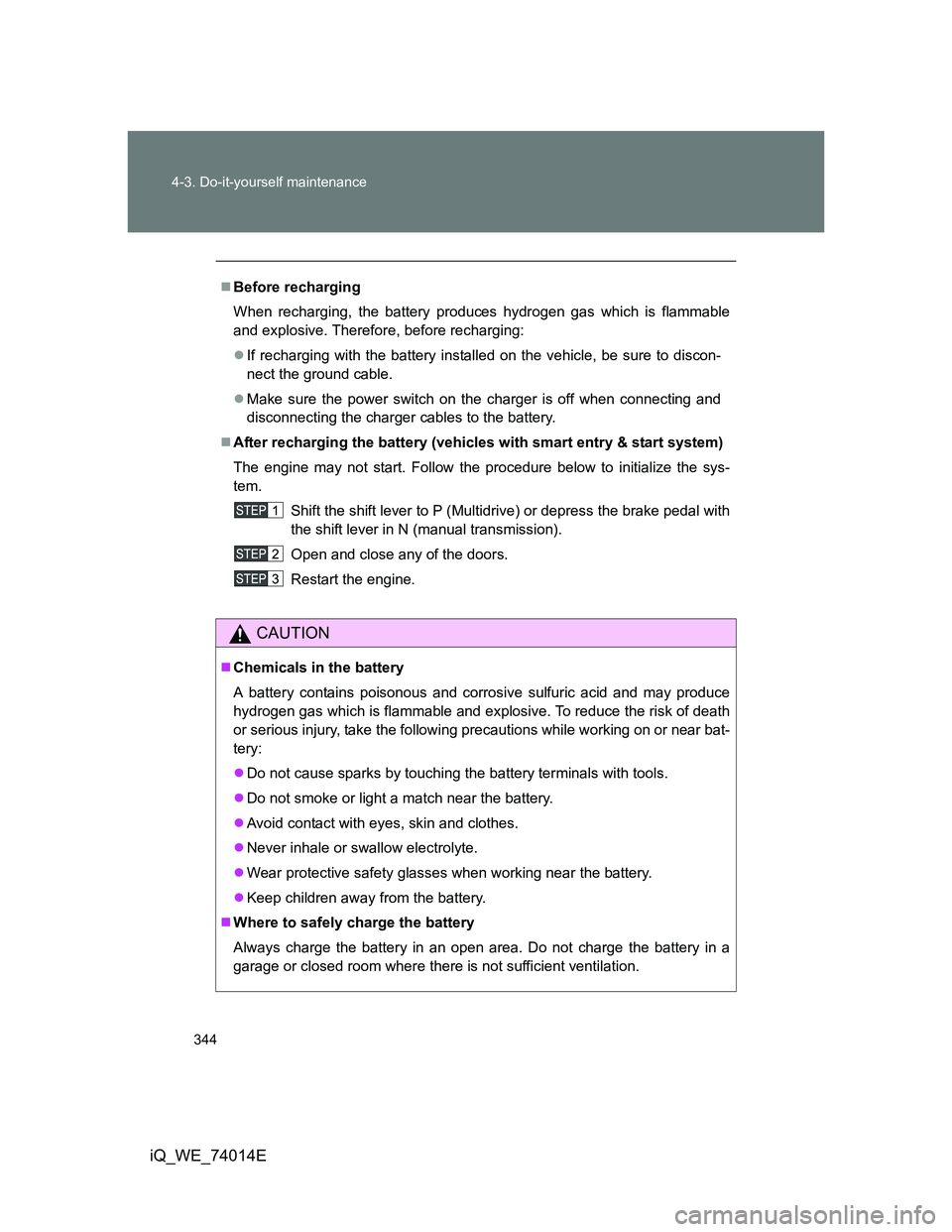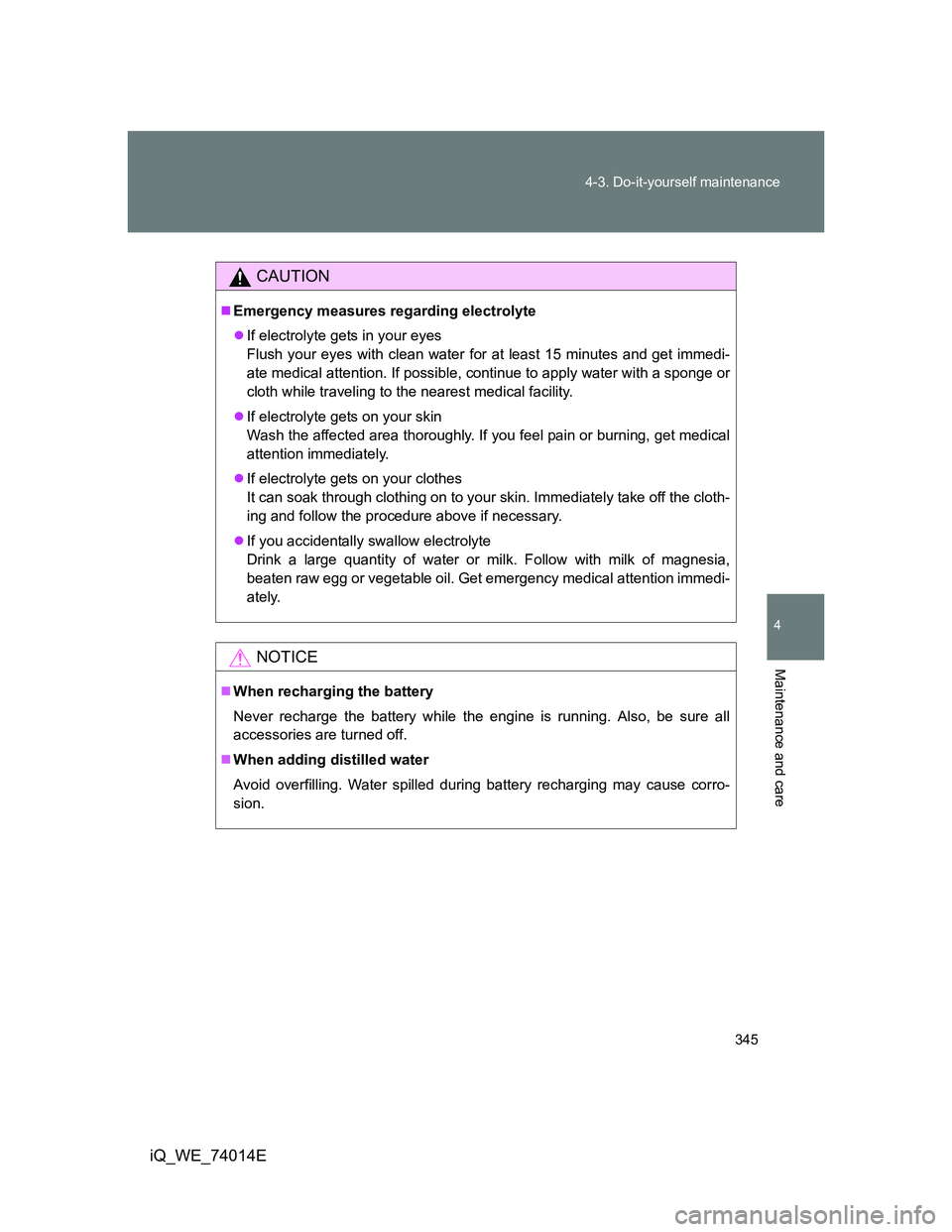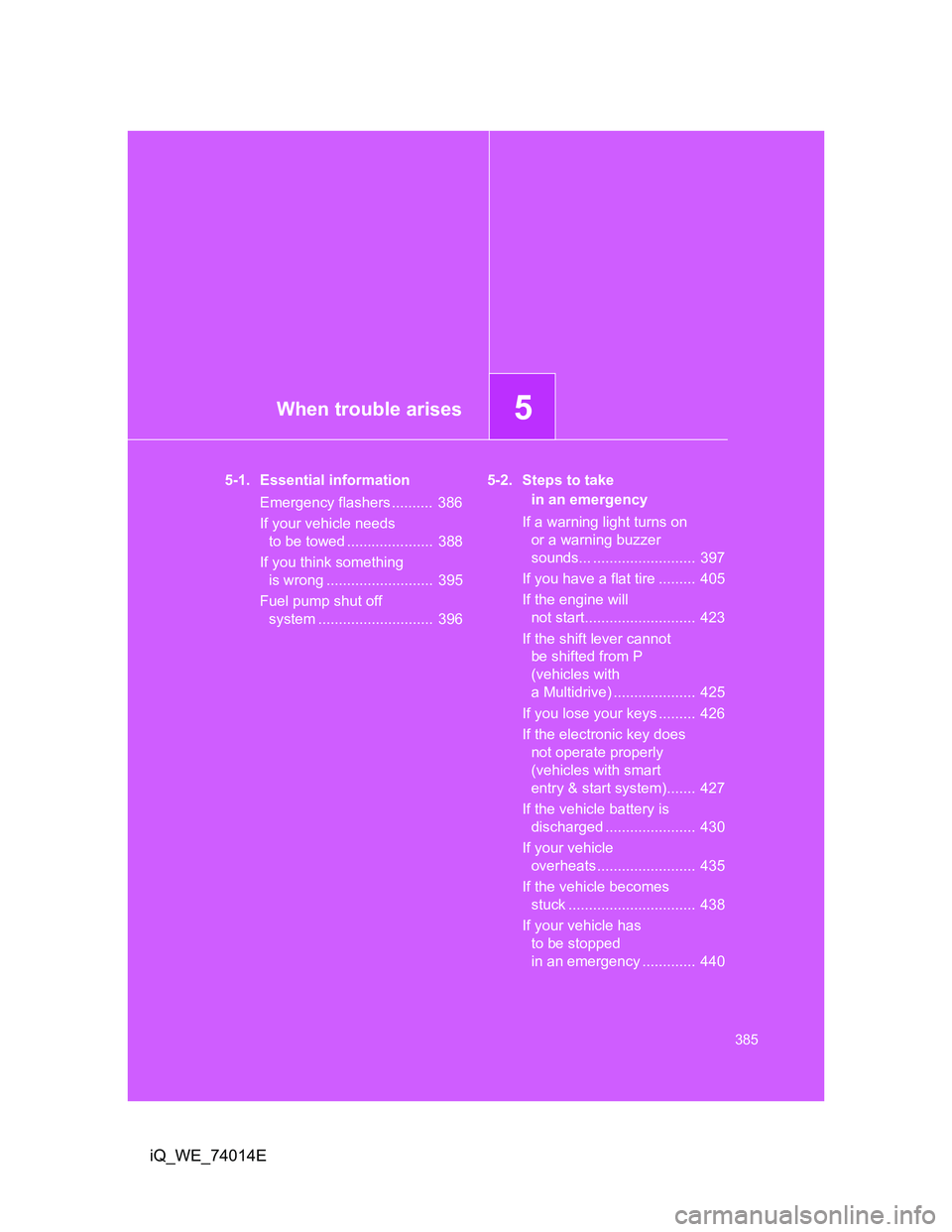Page 343 of 476
343 4-3. Do-it-yourself maintenance
4
Maintenance and care
iQ_WE_74014EBattery exterior
Make sure that the battery terminals are not corroded and that
there are no loose connections, cracks, or loose clamps.
Terminals
Hold-down clamp
Checking battery fluid
Check that the level is between
UPPER and LOWER.
UPPER
LOWER
If the fluid level is at or below
LOWER, add distilled water.
Adding distilled water
Remove the vent plug.
Add distilled water.
If the UPPER line cannot be
seen, check the fluid level by
looking directly at the cell.
Put the vent plug back on and close securely.
Page 344 of 476

344 4-3. Do-it-yourself maintenance
iQ_WE_74014E
Before recharging
When recharging, the battery produces hydrogen gas which is flammable
and explosive. Therefore, before recharging:
If recharging with the battery installed on the vehicle, be sure to discon-
nect the ground cable.
Make sure the power switch on the charger is off when connecting and
disconnecting the charger cables to the battery.
After recharging the battery (vehicles with smart entry & start system)
The engine may not start. Follow the procedure below to initialize the sys-
tem.
Shift the shift lever to P (Multidrive) or depress the brake pedal with
the shift lever in N (manual transmission).
Open and close any of the doors.
Restart the engine.
CAUTION
Chemicals in the battery
A battery contains poisonous and corrosive sulfuric acid and may produce
hydrogen gas which is flammable and explosive. To reduce the risk of death
or serious injury, take the following precautions while working on or near bat-
tery:
Do not cause sparks by touching the battery terminals with tools.
Do not smoke or light a match near the battery.
Avoid contact with eyes, skin and clothes.
Never inhale or swallow electrolyte.
Wear protective safety glasses when working near the battery.
Keep children away from the battery.
Where to safely charge the battery
Always charge the battery in an open area. Do not charge the battery in a
garage or closed room where there is not sufficient ventilation.
Page 345 of 476

345 4-3. Do-it-yourself maintenance
4
Maintenance and care
iQ_WE_74014E
CAUTION
Emergency measures regarding electrolyte
If electrolyte gets in your eyes
Flush your eyes with clean water for at least 15 minutes and get immedi-
ate medical attention. If possible, continue to apply water with a sponge or
cloth while traveling to the nearest medical facility.
If electrolyte gets on your skin
Wash the affected area thoroughly. If you feel pain or burning, get medical
attention immediately.
If electrolyte gets on your clothes
It can soak through clothing on to your skin. Immediately take off the cloth-
ing and follow the procedure above if necessary.
If you accidentally swallow electrolyte
Drink a large quantity of water or milk. Follow with milk of magnesia,
beaten raw egg or vegetable oil. Get emergency medical attention immedi-
ately.
NOTICE
When recharging the battery
Never recharge the battery while the engine is running. Also, be sure all
accessories are turned off.
When adding distilled water
Avoid overfilling. Water spilled during battery recharging may cause corro-
sion.
Page 357 of 476
357
4-3. Do-it-yourself maintenance
4
Maintenance and care
iQ_WE_74014E
Key batter y
Replace the battery with a new one if it is discharged.
You will need the following items:
Flathead screwdriver (To prevent damage to the key, cover
the tip of the screwdriver with tape.)
Small flathead screwdriver
Lithium battery
Vehicles without smart entry & start system: CR2016
Vehicles with smart entry & start system: CR1632
Replacing the battery
Vehicles without smart entry & start system
Remove the cover.
Remove the module.
Page 358 of 476
358 4-3. Do-it-yourself maintenance
iQ_WE_74014E
Open the case cover using a
coin protected with tape etc.
and remove the depleted bat-
tery.
Insert a new battery with the
“+” terminal facing up.
Vehicles with smart entry & start system
Push the release button and
take out the mechanical key.
Remove the cover.
Page 359 of 476
359 4-3. Do-it-yourself maintenance
4
Maintenance and care
iQ_WE_74014E
If the key battery is discharged
The following symptoms may occur.
The smart entry & start system (if equipped) and wireless remote control
will not function properly.
The operational range is reduced.
Use a lithium battery
Batteries can be purchased at any authorized Toyota dealer or repairer,
or another duly qualified and equipped professional, jewelers, or camera
stores.
Replace only with the same or equivalent type recommended by any
authorized Toyota dealer or repairer, or another duly qualified and
equipped professional.
Dispose of used batteries according to local laws.
Remove the depleted battery.
Insert a new battery with the
“+” terminal facing up.
Page 360 of 476
360 4-3. Do-it-yourself maintenance
iQ_WE_74014E
CAUTION
Removed battery and other parts
These parts are small and if swallowed by a child, they can cause choking.
Keep away from children. Failure to do so could result in death or serious
injury.
Certification for the key battery
RISK OF EXPLOSION IF BATTERY IS REPLACED BY AN INCORRECT
TYPE. DISPOSE OF USED BATTERIES ACCORDING TO THE INSTRUC-
TIONS.
NOTICE
For normal operation after replacing the battery
Observe the following precautions to prevent accidents.
Always work with dry hands.
Moisture may cause the battery to rust.
Do not touch or move any other components inside the remote control.
Do not bend either of the battery terminals.
Page 385 of 476

5When trouble arises
385
iQ_WE_74014E
5-1. Essential information
Emergency flashers .......... 386
If your vehicle needs
to be towed ..................... 388
If you think something
is wrong .......................... 395
Fuel pump shut off
system ............................ 3965-2. Steps to take
in an emergency
If a warning light turns on
or a warning buzzer
sounds... ......................... 397
If you have a flat tire ......... 405
If the engine will
not start........................... 423
If the shift lever cannot
be shifted from P
(vehicles with
a Multidrive) .................... 425
If you lose your keys ......... 426
If the electronic key does
not operate properly
(vehicles with smart
entry & start system)....... 427
If the vehicle battery is
discharged ...................... 430
If your vehicle
overheats ........................ 435
If the vehicle becomes
stuck ............................... 438
If your vehicle has
to be stopped
in an emergency ............. 440